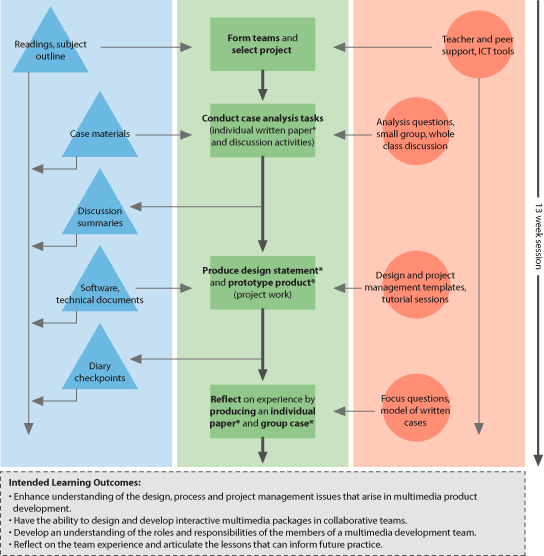|
ACCESSIBLE RESOURCES
The resources, developed as a collection of html and pdf files,
are delivered online as part of a WebCT site, and on CD-ROM
as a back-up in case Web access is a problem. Resources available
to students as part of this subject are:
Readings: The cases are supplemented with readings that include
papers and articles about the multimedia development process,
and technical tips for media production.
Subject outline: This document provides information about
the subject, in particular the schedule and the assessment
requirements. Associated documents on the Web site provide
a detailed outline of suggested weekly activities, including
links to readings and other resources.
Case materials: Two real-life cases are the main resource
provided. These are a rich information source providing learners
with access to a project overview and timeline, transcribed
interviews with the key designers, original project documents
and relevant literature. Students are also provided with a
copy of each of the CD-ROMs which were the outcome of the
projects.
Discussion summaries (student-generated): At the end of their
small group discussions each team prepares a brief summary
of the main points and posts these to the WebCT discussion
forum. These summaries are accessible to the whole class,
and provide a record of the discussion for later reference.
Software tools and technical documentation: Students are
provided with access to the software tools they need to complete
their projects and the necessary technical manuals through
the on-campus lab facilities and software library. Teams work
with the instructor to determine what resources they require.
Diary checkpoints (student-generated): Several times during
the session students are asked to post a message about their
progress. These enable the class to maintain contact between
meetings, and encourage learners to reflect on their progress.
Issues raised in the diary checkpoints become discussion points
at class meetings and on the WebCT forum.
Students are encouraged to seek out further resources of
relevance to their specific project needs.
RESOURCES IN CONTEXT
These resources are unique in that they present a detailed,
rich case study of two multimedia design cases. The use of
electronic files allows a significant collection of resources
to be compiled, much larger than if it was presented in print
form, and enables the inclusion of visual and dynamic files
(e.g. screen graphics and prototypes).
VARYING THE RESOURCE SET
The case materials are essential resources. There is some
flexibility in the supplementary readings provided.
|
